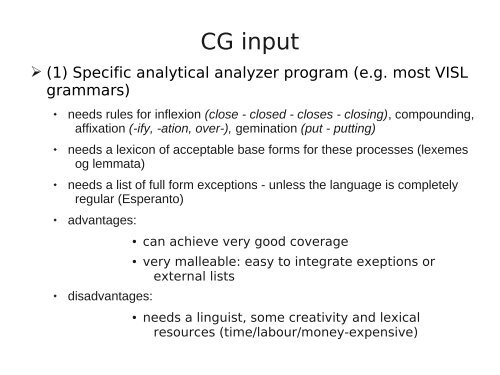On how to write rules in Constraint Grammar (CG-3) - VISL
On how to write rules in Constraint Grammar (CG-3) - VISL
On how to write rules in Constraint Grammar (CG-3) - VISL
Create successful ePaper yourself
Turn your PDF publications into a flip-book with our unique Google optimized e-Paper software.
<strong>CG</strong> <strong>in</strong>put<br />
➢ (1) Specific analytical analyzer program (e.g. most <strong>VISL</strong><br />
grammars)<br />
<br />
<br />
<br />
<br />
<br />
needs <strong>rules</strong> for <strong>in</strong>flexion (close - closed - closes - clos<strong>in</strong>g), compound<strong>in</strong>g,<br />
affixation (-ify, -ation, over-), gem<strong>in</strong>ation (put - putt<strong>in</strong>g)<br />
needs a lexicon of acceptable base forms for these processes (lexemes<br />
og lemmata)<br />
needs a list of full form exceptions - unless the language is completely<br />
regular (Esperan<strong>to</strong>)<br />
advantages:<br />
●<br />
●<br />
disadvantages:<br />
●<br />
can achieve very good coverage<br />
very malleable: easy <strong>to</strong> <strong>in</strong>tegrate exeptions or<br />
external lists<br />
needs a l<strong>in</strong>guist, some creativity and lexical<br />
resources (time/labour/money-expensive)
















